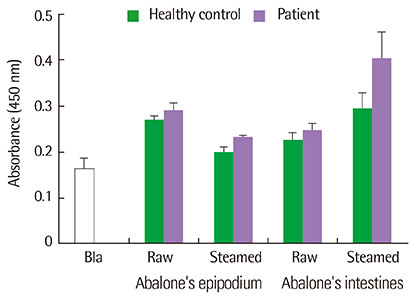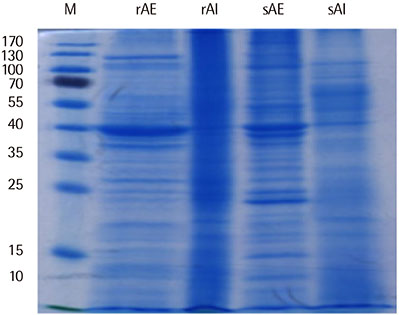Allergy Asthma Respir Dis.
2016 Nov;4(6):449-452. 10.4168/aard.2016.4.6.449.
Anaphylaxis after consumption of abalone
- Affiliations
-
- 1Department of Internal Medicine, Gachon University Gil Medical Center, Incheon, Korea. allergy21@hotmail.com
- KMID: 2361261
- DOI: http://doi.org/10.4168/aard.2016.4.6.449
Abstract
- Abalone is popular seafood in Asia; however, allergy to abalone was rarely reported. We report a case of anaphylaxis after consumption of abalone. A 24-year-old female visited an Emergency Department, complaining of cough, dyspnea, rhinorrhea, generalized urticaria, facial edema, and wheezing that had developed 1 hour after consumption of abalone. She was discharged when her symptoms subsided after antihistamine and dexamethasone were given. One month later, she was referred to our outpatient clinic. We performed skin prick tests, measurement of serum specific IgE antibody level, and sodium dodecyl sulfate-polyacrylamide gel electrophoresis (SDS-PAGE) with IgE immunoblotting. Both skin prick and specific IgE antibody tests were positive for abalone crude extract. In SDS-PAGE with IgE immunoblotting, we identified possible antigens sized 55, 100, and 25 kDa, respectively. This is the first case of abalone-induced anaphylaxis in Korea.
Keyword
MeSH Terms
-
Ambulatory Care Facilities
Anaphylaxis*
Asia
Cough
Dexamethasone
Dyspnea
Edema
Electrophoresis
Electrophoresis, Polyacrylamide Gel
Emergency Service, Hospital
Female
Food Hypersensitivity
Humans
Hypersensitivity
Immunoblotting
Immunoglobulin E
Korea
Respiratory Sounds
Seafood
Shellfish
Skin
Sodium
Urticaria
Young Adult
Dexamethasone
Immunoglobulin E
Sodium
Figure
Reference
-
1. Verrill L, Bruns R, Luccioli S. Prevalence of self reported food allergy in US adults: 2001, 2006, and 2010. Allergy Asthma Proc. 2015; 10. 08. [Epub].
Article2. Lee AJ, Gerez I, Shek LP, Lee BW. Shellfish allergy: an Asia-Pacific perspective. Asian Pac J Allergy Immunol. 2012; 30:3–10.3. Clarks PS. Immediate respiratory hypersensitivity to abalone. Med J Aust. 1979; 1:623.
Article4. Lopata AL, Zinn C, Potter PC. Characteristics of hypersensitivity reactions and identification of a unique 49 kd IgE-binding protein (Hal-m-1) in abalone (Haliotis midae). J Allergy Clin Immunol. 1997; 100:642–648.
Article5. Suzuki S, Nakamura Y, Nishioka K, Adachi M. A case of anaphylaxis caused by abalone diagosed with prick by prick test. Arerugi. 2007; 56:593–597.6. Masuda K, Tashima S, Katoh N, Shimakura K. Anaphylaxis to abalone that was diagnosed by prick test of abalone extracts and immunoblotting for serum immunoglobulin E. Int J Dermatol. 2012; 51:359–360.
Article7. Lack G. Clinical practice. Food allergy. N Engl J Med. 2008; 359:1252–1260.8. Umasunthar T, Leonardi-Bee J, Turner PJ, Hodes M, Gore C, Warner JO, et al. Incidence of food anaphylaxis in people with food allergy: a systematic review and meta-analysis. Clin Exp Allergy. 2015; 45:1621–1636.
Article9. Atkins D, Bock SA. Fatal anaphylaxis to foods: epidemiology, recognition, and prevention. Curr Allergy Asthma Rep. 2009; 9:179–185.
Article10. Wang J, Sampson HA. Food anaphylaxis. Clin Exp Allergy. 2007; 37:651–660.
Article11. Jin HJ. Anaphylaxis: diagnosis, management, and current barriers. Allergy Asthma Respir Dis. 2016; 4:79–81.
Article12. Jang GC, Chang YS, Choi SH, Song WJ, Lee SY, Park HS, et al. Overview of anaphylaxis in Korea: diagnosis and management. Allergy Asthma Respir Dis. 2013; 1:181–196.
Article13. Maeda S, Morikawa A, Kato M, Motegi Y, Shigeta M, Tokuyama K, et al. 11 cases of anaphylaxis caused by grand keyhole limpet (abalone like shellfish). Arerugi. 1991; 40:1415–1420.14. Shin YK, Lee WC, Kim DW, Son MH, Kim EO, Kim SH, et al. Seasonal changes in physiology of the abalone Haliotis discus hannai reared from Nohwa Island on the South Coast of Korea. Korean J Malacol. 2012; 28:131–136.
Article15. Lee JS, Won SH, Kim SK, Lim HK, Lee JS. Classification and description of genus Nordotis (Gastropoda: Vestigastropoda) from Korea. Korean J Malacol. 2014; 30:79–86.
Article16. Lee JS, Min DK. A catalogue of Molluscan Fauna In Korea. Korean J Malacol. 2002; 18:93–217.17. Won SH, Kim SK, Kim SC, Yang BK, Lim BS, Lee JH, et al. The morphological characteristics of four Korean Abalone species in Nordotis. Korean J Malacol. 2014; 30:87–93.
Article18. Son MH. Standard manual of abalone culture. Pusan: National Institute of Fisheries Science;2008.19. Leung PS, Chu KH. Molecular and immunological characterization of shellfish allergens. Front Biosci. 1998; 3:d306–d312.
Article20. Chu KH, Wong SH, Leung PS. Tropomyosin Is the major mollusk allergen: reverse transcriptase polymerase chain reaction, expression and IgE reactivity. Mar Biotechnol (NY). 2000; 2:499–509.
Article
- Full Text Links
- Actions
-
Cited
- CITED
-
- Close
- Share
- Similar articles
-
- Food allergies and food-induced anaphylaxis: role of cofactors
- Measurement of specific IgE to abalone(Haliotis discus hannai) and identification of IgE binding components
- Anaphylaxis caused by honey: a case report
- Failure of anti-Il-4 antibody to prevent the chicken-gamma globulin-induced active systemic anaphylaxis: involvement of IgG antibodiesin induction of the anaphylaxis
- Experimental Studies on the Relation between Nicotine and Sexual Hormone: Part IV. The Antidotal Action of Luteohormone on Nicotine Toxicity during Anaphylaxis: B. The Effect of Luteohormone on Anaphylaxis




